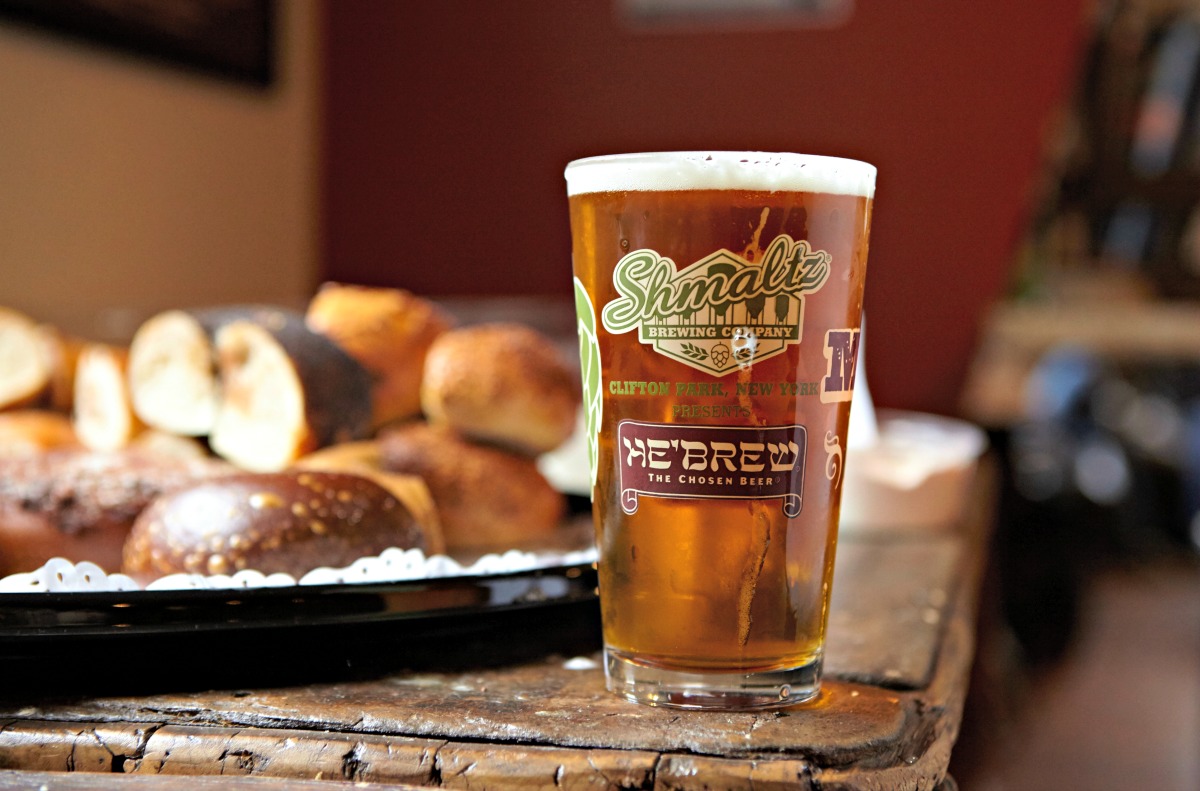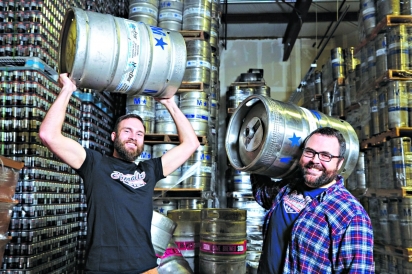Shmaltz Brewing Co. Ferments a New Beer Culture
Being the biggest, smallest, most critically lauded and the only Jewish celebration brewery in the world simply isn’t enough. Shmaltz Brewing Company is out to change ... spelling conventions.
The letter “c” does not belong in the word “schmaltz,” the beer-makers argue, and they would prefer that all stay true to Shmaltz’s contemporary roots, honor Leo Rosten and bestow upon the brewery this well deserved 20th anniversary present.
Aiming to give Webster a makeover is a rather offbeat business goal for a crew of brewers at first glance, perhaps. But nothing about Shmaltz is typical.
How on earth do they have the chutzpah to drop the “c,” and what on earth does it have to do with a decent mug of beer, a skeptic may wonder?
The Clifton Park brewery cites two Jewish authorities as inspiration in their quixotic quest: the renowned Yiddish lexicographer Leo Rosten, whose magnum opus The Joys of Yiddish (Pocket, 1968), adhered to the “sh” spelling, and with a bemused mixture of fear and reverence, they point to Shmaltz founder Jeremy Cowan’s grandmother and her assertion there shouldn’t be a “c” in certain Yiddish words (e.g., schmutz, schlepp, schtick, schnorrer, schnecken, etc.).
Shmaltz has launched a petition on Change.org formally demanding that Google, Apple, Microsoft and what they refer to as “The Internets” cease and desist from the appalling practice of autocorrecting shmaltz to schmaltz.
“Spelling shmaltz with a ‘c’ is an outrage,” Greg Chanese, marketing director at Shmaltz, explains with as much solemnity as he can muster. It’s clearly more than just an office inside-joke kicked up a notch, though. “Everyone who works here believes that what we’re doing is about more than just beer. Yes, our ultimate goal is to make amazing beer that people love. But we also want to make them think and we want to contribute to the community and culture, and use beer as a medium to bring people together in a real way.”
A funky spelling in a company’s name can also have very real economic implications. In the era of Google, a name suffering from autocorrect syndrome can wreak havoc on a company’s ability to master, maneuver and guide its own image online, which these days, is essential to any growing company’s bottom line. (The spelling has even created issues with GPS).
And growing it is.
Shmaltz was created on a lark in 1996 when Jeremy Cowan was in college. Cowan was fascinated by his Jewish heritage and culture and began to explore the way this and his passion for craft beer could intersect. For the most part, historically, they did not. As Egyptians and Mesopotamians began fermenting grains for beer thousands of years ago, Israelites primarily turned juicy grapes into wine. That started changing in the mid-1800s when German-Jewish Brooklyn immigrant Samuel Liebmann founded Rheingold Beer, one of the most successful breweries in America until it shuttered in the mid-1970s.
The success of Rheingold opened the door and helped overturn some of the stereotypes about a general disinterest in alcohol, especially beer, among Jews. Many prominent craft brewers are Jewish these days (Alan Newman and Matt Cohen of Magic Hat Brewery, Ken Grossman of Sierra Nevada, to name a few), but Cowan was the first to leverage the beloved foodways, cultural touchstones and essential everyday ingredients that are part and parcel of his heritage as a way of defining his brand.
“Jeremy joked with his friends at Stanford about how funny it would be to start He’Brew,” Greg says. “He really did the initial batch as an experiment and marketed it for Chanukah.”
Armed with pithy slogans (“Don’t Pass Out ... Passover,” “Perfect for Bar Mitzvahs, Weddings and Circumcisions”), he launched Shmaltz out of the back of his grandmother’s Volvo in San Francisco in 1996, hand-bottling and often personally delivering the first 100 cases of its He’Brew beer. The next year, he realized he had more than shtick on his hands, so he moved production to Anderson Valley Brewing Company and began a long, nomadic journey to Clifton Park.
After 17 years of contract brewing, most recently at Olde Saratoga Brewing, Shmaltz opened the Clifton Park production brewery in 2013. With a 1,700-square-foot tasting room, 20,000 barrels of annual capacity and beer delivered across 35 states through 40 distributors and 5,000 retailers, Shmaltz is a multimillion dollar, highly tuned business engine that often sees double-digit growth year-over-year.
For a company whose three pillars are community, quality and (yes) shtick, a sense of humor and an inherent ability to not only hold—but execute—two opposing ideas simultaneously is a job requirement.
Touring their impeccable facility, which features custom-made brew tanks, a 120-bottle-per-minute packaging line, dozens of barrels aging beer, cases of beer stacked to the ceiling and waiting to ship out across the country, laughter rings through the air, but the atmosphere is dead serious. Work gets done, and work is fun.
Again. Shmaltz contradicts itself even on the back end, turning a job into play, without sacrificing serious beer geek chops or a healthy bottom line.
This is a beer created by and for unabashed, unashamed brew nerds. Shmaltz merited inclusion on RateBeer’s list of the Top 100 Brewers in the World and earned 10 gold and six silver medals from the World Beer Championships in recent years.
Their head brewer, Richie Saunders, “attacks beer from a culinary angle,” marketing director Chanese says. “He understands how flavors interplay and the manner in which complexity can be coaxed out of different ingredients during different stages of the brewing process.
A lot of our beers are extremely experimental and flavorful, but we also have more straightforward styles that will appeal to people who really just want a nice lager with clean tasting notes.”
The brewery uses national and New York–grown ingredients, and Shmaltz will be launching a new series called 518/838 that celebrates the Empire State in the first quarter of 2017.
Shmaltz also focuses on the delicious ingredients everyone associates with the Middle East. Pomegranates, figs and dates are featured prominently in Shmaltz’s products, to delicious effect.
There are four brewery favorites: an American lager called Slingshot (the name is a play on the David and Goliath tale, with Shmaltz as David and Goliath as Big Beer), an IPA called Hop Manna (a play on manna aka heaven), a nut brown ale named Messiah (humility is overrated) and a rye double IPA dubbed Bittersweet Lenny’s (a tribute to the late, great Jewish comic Lenny Bruce). There are seasonals, many of which revolve around the seasons and some Jewish holidays (i.e., Chanukah, Hanukkah: Pass the Beer) and barrel-aged 22-ounce bombers, plus the occasional limited release, such as the Collector’s Edition Star Trek 50th Anniversary releases: the Trouble with Tribbles and Voyage to the Northeast Quadrant.
While Shmaltz is widely available, the best place to drink it is right there in the brewery. If there’s any excuse for a party (Jewish and secular holidays, the fact that it’s Friday, Saturday or Sunday, a new beer on tap, Uncle Lenny is in town, etc.), Shmaltz is there, throwing one, with a vengeance. They also hold Pints for a Cause nights, where eligible charities can rake in $1 for every pint or flight purchased.
For a lapsed (sorry Grandma!) Catholic of Anglo-Saxon descent, there are few better ways to spend a Sunday afternoon than at Shmaltz’s weekly Beers & Shmears. My favorite way to go is Death Hoppy Ale, made with seven hops (Cascade, Citra, Summit, Crystal, Amarillo, Ahtanum, Chinook) and notes of milk chocolate and espresso, and then my favorite way to be reborn is R.I.P.A.— Rye Double IPA, which delivers a toasty malt backbone, a lashing of dry hops
and a soothing, warm finish. Like a slightly violent bear hug from a beloved sibling, Shmaltz beers are big, bold, unforgettable.
The vibe is decidedly jovial. There are board games to play. Couches on which to sprawl. Hi-tops and stools on which to perch and geekily compare tasting notes. Video games. Free bagels, two- for-one beer specials, and a staff of cheerful beer people who are more than happy to answer your multipart questions and discuss the merits of dry versus wet hopping, the difference between beers aged in bourbon barrels or rye whiskey barrels, and the merits of limited filtering.
Beer is culture, and exploring it through a Jewish lens is an invigorating, lip-smacking taste revolution that makes you rethink all of the things you thought you knew about the development of Western Civilization (or at the very least, notions about pomegranates and beer). Hey, maybe they’ve even got a point about that “c” thing.
L’Chaim!







